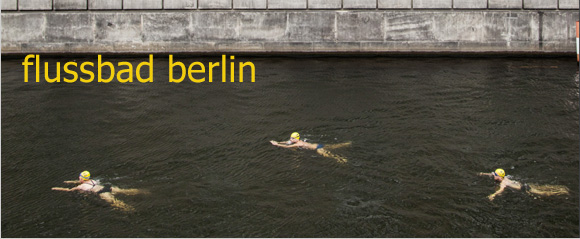
In Berlin, the non-profit organization Flussbad Berlin e.V. has set itself a highly ambitious goal: to transform the largely unused Spree Canal in the downtown district of Berlin Mitte into an ecologically sound and easily accessible site open to all Berliners and visitors to the city.
Barbara SCHINDLER
photos Annette Hauschild / OSTKREUZ
h2o – 2017 August
The idea was first developed by Tim Edler in the late 1990’s. At that time he was, together with his brother Jan Edler, running an independent art association called "Kunst und Technik" (known for its illegal night club) right next to the river Spree in the very city centre and they discovered that the Spree Canal was unused. With some artist friends they started thinking about the potentials of that huge neglected inner city void. But Berlin had other issues to solve at that time, and so considering the Spree river as a natural resource was not a priority yet. After the first public presentation of the Flussbad project in 1998 the Edler brothers (alias "realities:united studio for art and architecture") – solely driven by enthusiasm for the concept – kept working on the project on an irregular basis. Finally, when the project received the prominent Holcim Award – the equivalent of the Pritzker Prize, but for sustainable construction – in two consecutive years (2011 and 2012), a tremendous amount of interest on the potentials of the Flussbad project was generated. In December 2012 the non-profit organization Flussbad Berlin e.V. was found by 15 Flussbad enthusiasts in order to support and foster the further communication and development of the project idea. Today the association counts nearly 700 members and supporters.
In mid-2014, the project received funding from the German Lotto Foundation (Stiftung Deutsche Klassenlotterie) to prove the basic feasibility of the project with regard to water quality and flood protection. The study was completed and the (positive!) findings published and presented to the public in October 2015. At the end of 2014, the project also received € 4,000,000 in funding as part of the National Urban Development Projects programme from Germany's Federal Government and the Federal State of Berlin. Based upon these resources Flussbad Berlin e.V. now tries to have the concept developed into a tangible implementation project by the end of 2018.
A political decision on the realization of the project has not been taken yet. With the current funding until 2018 we aim to develop the project to a stage that a political decision can and will be taken. In 1925, the last public swimming facility within river Spree had to be closed due to the growing pollution of the river. We aim to reopen the Flussbad Berlin in 2025, hence 100 years later…
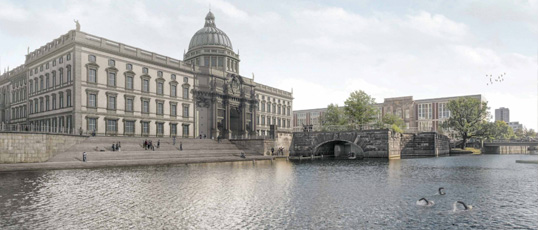 |
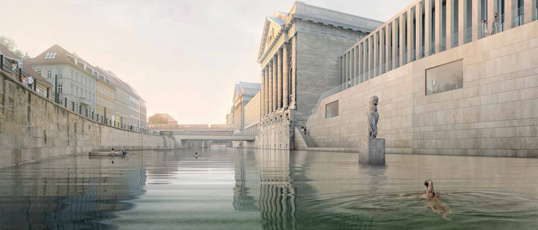 |
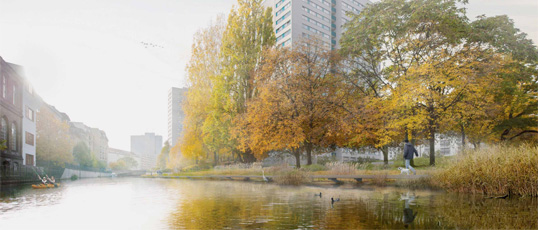 |
Our plan divvies up the Spree Canal into three sections, each with its own unique use, atmosphere and function.
Swimming area – This 835-metre section of the canal is situated against the imposing backdrop of the historical structures on Museum Island and has clean river water for swimming. This water-space has been largely unused for decades and will be made accessible via largescale stairways located at the Lustgarten or the Humboldt Forum [see p. 28]. As a natural resource in the middle of the city, this new public space will attract residents and visitors alike back to the city centre: to gather, relax or swim in the clear water. This everyday sensory experience will give people a new perspective on the historical city and create a new level of use, perception and meaning for the increasingly streamlined area of Berlin-Mitte. It will also enhance its cultural and social meaning and make it sustainable for the future.
Natural water-filter area – An ecological plant filter between Gertraudenbrücke and the Federal Foreign Office will clean the canal water running through it, which is contaminated by occasional discharges from Berlin’s combined sewer system. Here, the water will flow over a stretch of almost 400 metres through a 1-metre thick gravel layer lined with aquatic plants. The microbiological cleansing of the water that takes place in this section will make it possible to swim care-free in the water that emerges after filtering. This continuous process is powered solely by gravity; in other words, the filtered water flows naturally into a swimming area that lies at a level that is roughly 1.5 metre lower.
Renaturised river area – The section of the canal in the Fischerinsel area will be transformed into an ecological regeneration zone in a manner similar to an oxbow lake. In the context of the many kilometres of canalised Spree River that run through Berlin, the shallow-water zones along the embankment in this section will create much-needed living and reproduction space for flora and fauna. This would mark a significant contribution to the ecological improvement of waterways, an international obligation to which Berlin must abide. By removing select parts of the canal wall, this section will create green areas with shallow riverbanks that will act as an "historical window" on Berlin’s old city walls that have remained hidden until now. A new jetty at water level would invite visitors to explore the canal. ▄
 |
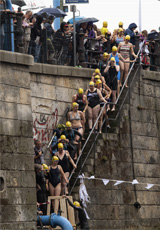 |
 |
 |
|
| Flussbad Berlin e.V. Falckensteinstraße 48 10997 Berlin Tel. +49 30 5557445-0 info@flussbad.berlin |